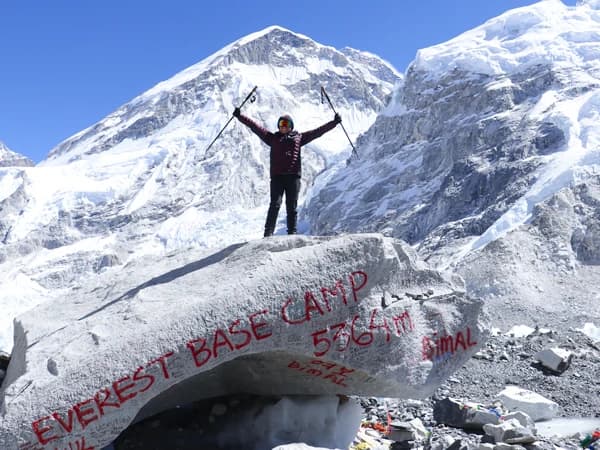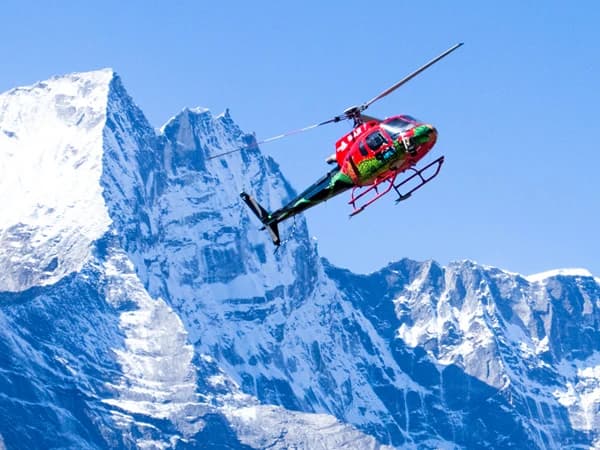Difficulty level of 2025 trek
The difficulty level of the EBC with Island Peak Climbing Trek 2025 is graded as strenuous, requiring previous experience and technical climbing skills. The trek involves long days of walking (approximately 5-8 hours daily) over varied terrain, including steep ascents and descents.
The highest elevation reached during the trek also determines the Everest base camp trek with island peak climbing difficulty level, as there is a high chance of getting high altitude symptoms at 6,189 meters. The journey is much more difficult than just going for the Everest Base Camp short trek.
The total journey is 20 days and requires mental resilience and physical fitness. The trekker must be able to face the harsh weather conditions while climbing the island peak. He/she needs to learn the basic mountaineering techniques, such as using crampons and ice axes.
Permits required for 2025 trek
For the Everest Base Camp trekking with Island Peak climbing 2025, you will need two permits: the Sagarmatha National Park Entry Permit, the Khumbu Pasang Lhamu Rural Municipality Entry Permit, and the Island Peak Climbing Permit.
The cost of the Sagarmatha National Park permit is USD 30, the Khumbu Pasang Lhamu Municipality Entry Permit is USD 20, and the Island Peak Climbing Permit is USD 250 (spring) & USD 125 (autumn). The documents required for the permit are a valid passport (with at least 6 months of validity), passport-sized photos, and a valid visa.
If you want to fly the drones in this region, you will need a drone permit. Learn more about the drone laws in Nepal from the link.
Note: The expenses of the permits are included in the Everest base camp trekking with Island Peak climbing cost inclusions.
Best time to go on 2025 trek
The best time to go for the Island Peak climbing with the Everest Base Camp trek in 2025 is during March to May and September to November. The months March to May are because the weather conditions are generally stable, skies are clear, temperatures are moderate, and precipitation is also low. The flowers bloom during these months.
The months September to November offer the same conditions as March, April, and May. The views of the Himalayas can be seen clearly. and the temperatures become perfect for the trekking. Some people try the early december for the trek to the Everest base camp with Island Peak climbing too.
Note: The Everest base camp trek with Island Peak climbing price is higher in the spring season, as the price of the climbing permit surges up to USD 250, than in the autumn season.
Food and accommodations during 2025 trek
During the EBC trek with Island Peak climbing, you will get diverse food options from local to international cuisines. However, the food options may be limited in the higher elevations. The food options according to the meal timing include:
- Breakfast: toast, omelet, Thukpa, garlic soup, Tibetan bread, eggs, porridge, and omelets
- Lunch: Tibetan bread with jam, soups, Tsampa, Sherpa stew (shyakpa), daal bhaat tarkari, sandwiches, momos (dumplings), pizza, and so on.
- Dinner: rice with curry, fried noodles, yak meat, pasta, Gundruk aachar, and local specialties.
In terms of accommodation, you can get a variety of options. We offer the best teahouse available during your course of trekking in the Everest region. The teahouses will be simple but cozy. The houses will have minimal amenities, with a hot shower and wifi available for a small fee.
In case of climbing Island Peak, you will have to spend a night in tents at the Island Peak base camp. Meals are prepared hygienically and will be a basic option as compared to teahouses.
Toilet and shower facilities
Most of the teahouses you will be staying in feature squat toilets. You may find the western-style toilets in the lower elevations like lukla, Namche bazaar and Phakding. At higher elevations, it is not possible because of freezing temperatures affecting the plumbing systems.
The shower facilities are available in most of the teahouses along the route. The lower-area accommodations in Lukla, Namche Bazaar, and Phakding often include the hot shower cost in the accommodation costs of the total Everest Base Camp trek with Island Peak climbing cost. The accommodations above charge for the hot shower facility due to the need for a gas heating system.
Note: The additional costs related to the hot shower are not included in the EBC trek with island peak climbing cost inclusions.
Telephone, Internet and electricity
The primary mobile service providers in the region are NCELL and NTC. From Lukla to Gorakshep, you will get decent 3G coverage. However, at higher elevations, the network strength may be unreliable. You can also use mobile data during the Everest base camp and Island Peak climbing using the local SIM.
In terms of full internet, you can use the wifi provided by the respective teahouses. The speed may be unreliable at some places or may be slow due to the multiple users. As an alternative, you can use the Everest link that offers the best speed.
You can charge the electronic devices at additional costs. Carrying power banks is recommended for those going to the Everest region. The sources of the electricity at the lower elevations are hydroelectricity, and at the higher elevations, it is solar power.
Note: The expenses of the internet, mobile recharges, and device charging costs are not included in the EBC trekking with Island Peak climbing cost inclusions.
Weather and Temperature
The weather and temperature during the Island Peak climb with the Everest Base Camp Trek vary season to season. So, understanding these variations is important before planning the trekking in the Everest region.
- The average daytime temperature at lower altitudes during the spring season can range from 10°C to 15°C (50°F to 59°F). The higher elevation is colder than the lower elevation, with temperatures dropping around -10°C (14°F) at night. The weather is stable during these days, with wind speed around 14 km/h.
- The daytime temperature during the summer season in the lower regions floats between 15°C and 20°C (59°F to 68°F). At higher elevations, the temperatures can drop below -5°C (23°F) due to the storms. There are high chances of precipitation with poor visibility and unstable weather conditions.
- During the autumn, the daytime temperature can reach up to 15°C (59°F) at the lower elevations. While the night temperatures in the higher elevations can drop below -6°C (21°F). The overall weather conditions are stable with less precipitation.
- In the winter season, the daytime temperature at base camp floats between -5°C and 5°C (23°F to 41°F). The nights are always chiller compared to days, dropping around -20°C to -30°C (-4°F to -22°F) at higher elevations. The conditions become harsh with strong winds and heavy snowfall in some areas.
For the real time info, you can also use the weather forecast apps.
Flight, transportation, and luggage for 2025 trek
When going on the EBC trek with Island Peak Climbing, you should be serious about flight prebookings, transportation planning, and luggage packing. Below is some useful information regarding the flight transportation and luggage for the EBC trek.
- International and Internal Flights: If you are traveling from abroad, then you will need a visa and passport. A visa on arrival is only for some countries; make sure to check your eligibility for the visa on arrival before booking the flight. You can carry 23 kg, including your hold baggage and hand luggage, on your international flight. If you choose to travel to Lukla via flight, then you can carry up to 15 kg for the internal flights. For extra weight on luggage, you need to pay an extra charge.
- Luggage needed for the trek: For your trek to EBC with Island Peak Climbing, a duffel bag of 80L capacity and a 50-65L backpack are enough for carrying essential equipment like gear and other items. Typically, the porter will carry the duffel bag while you are responsible for carrying your backpack. You may need a small, 20–30-liter day backpack to carry your essentials during the day’s hike.
Altitude sickness issues and acclimatization
The altitude sickness issues are a serious concern during the high-altitude treks and climbs, like the EBC trek with Island Peak climbing. The acute altitude sickness symptoms include headaches, nausea, fatigue, dizziness, loss of appetite, insomnia, and so on.
The Everest Base Camp trekking with Island Peak climbing itinerary is designed in such a way that you can complete the journey without suffering from altitude sickness. There are enough acclimatization days. However, some people may suffer for various reasons.
Some of the reasons for the altitude sickness issues are rapid ascent, dehydration, exhaustion, poor acclimatization, and so on. The prevention or acclimatization strategies include drinking enough fluids, gradual ascent, eating nutritious food items, avoiding alcohol and coffee, paying attention to the body signals, and so on.
Trekking equipment needed for 2025 trek
Various equipment and gear are needed for safety and comfort during the EBC trekking with Island Peak climbing. Below is a detailed packing list of the trekking gear and equipment for your successful journey.
- Clothing like a waterproof jacket, lightweight down jacket, waterproof trousers, lightweight trekking trousers, thermals, trekking t-shirts/shirts (2-3), fleece or warm mid-layer, warm gloves, wool hat and sun hat, sunglasses, spare underwear, buff or neck gaiter, worn-in waterproof hiking boots, lightweight trainers, and many more.
- Trekking gear like merino glove liners, gaiters, daypacks with rain covers, rucksacks or duffel bags, trekking poles, travel towels, two water bottles, water purification tablets/systems, headlamps with extra batteries, sleeping bags rated to -18°C/0°F, dry bags for keeping clothes dry, cameras with extra batteries and memory cards, and so on.
- Climbing gear like plastic shell mountaineering boots with high-altitude liners, crampons, alpine climbing harnesses, mountaineering axes with leashes, ascenders, belay devices, D-shaped locking carabiners (2) and non-locking carabiners (2), expedition-style gaiters, climbing helmets, etc.
- Other essential items include toiletries, a first aid kit, high-energy snacks for the trek, a portable charger and plug adapter, hand warmers or a hot water bottle, small lock(s) for your bags, and so on.
Customize Itineraries and Trip Extensions for 2025 season
Everest base camp trek with Island Peak Climbing itineraries can be customized, and trips can be extended further based on your preferences and fitness level. The customization of the trek itinerary means extra days for acclimatization days, side trips to nearby landmarks, and so on. Or, you can also try the standard Island Peak climbing with EBC for 19 days.
The trip extensions include visiting the nearby villages, monasteries, or viewpoints, or even extending your trek to include other destinations. As a mystic adventure representative, we will organize, customize, and extend your trekking journey through the Himalayas with diverse Everest base camp treks with island peak climbing itinerary options.
Tips to make the 2025 trekking journey smooth
- Train yourself physically and mentally for the several months before your trek, including important exercises like hill walking, stair climbing, and weight training.
- Gradual ascent to the higher altitude to prevent the altitude sickness symptoms.
- Double-check all the gear and clothing before embarking on the trek.
- Familiarize yourself with the basic mountaineering techniques, including crampons and ice axes. It will be better if you take the climbing course at the base camp.
- Carry a Nepali SIM card to use cellular data on the way (the network may not be stable all the time).
- Drink plenty of water to keep yourself hydrated. Hydration is the key to avoiding altitude sickness.
- Join a reputable trekking company or hire an experienced guide and climber.
- Study the Everest base camp trek with the Island Peak climbing map before the trek for mental readiness.
- Allow extra days in your itinerary for your body to adjust to the lower oxygen levels.
- Carry extra cash with you, as there are no ATMs at the higher elevations.
- Always say namaste to the locals, touching both palms and bending a little.
- Carry extra snacks to maintain the energy level throughout the trek.
- Respect local customs and the locals.
- Always walk on the mountainside, especially when yaks and mules are passing by.
- Ask permission before taking photographs of any object or person.
- You can tip any amount you like to the crew members. To give you a general idea, this is what we recommend:USD 150 to the porter & guide, USD 5 to the tour guide, and USD 2 to the driver
















